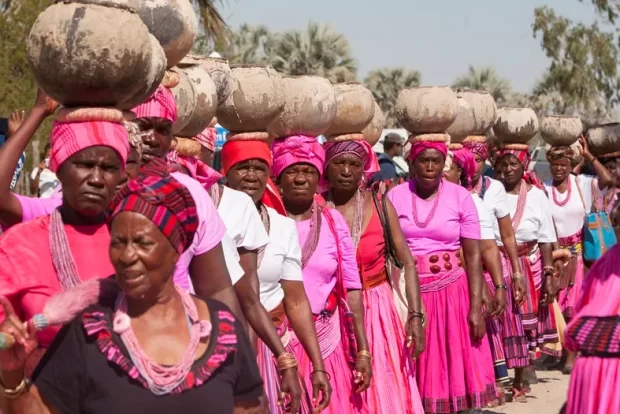Namibia, a country located in southern Africa, is renowned for its diverse cultures, traditions, and landscapes. However, one of the country’s most striking aspects is its rich linguistic diversity. With over 30 different languages spoken across the country, Namibia offers a fascinating study of how language and identity are interwoven in a modern, post-independence society. Among these languages, Oshiwambo stands out as the dominant language, with 48.9% of the population using it as their mother tongue.
This article will explore the significance of Oshiwambo in Namibia’s linguistic landscape, its role in shaping cultural identity, and the broader context of Namibia’s language diversity. We will also examine the challenges and opportunities arising from this linguistic richness and the implications for Namibia’s future.
Oshiwambo: The Dominant Language of Namibia
The language spoken by nearly half of Namibia’s population, Oshiwambo, is a Bantu language belonging to the larger Niger-Congo language family. It is spoken predominantly in the north-central and northern regions of Namibia, particularly in the Oshana, Omusati, Ohangwena, and Zambezi regions. The Oshiwambo-speaking people are part of the larger Ovambo ethnic group, the largest ethnic community in Namibia, accounting for around 50% of the country’s population.
Linguistic Characteristics of Oshiwambo
Oshiwambo is not a single monolithic language but rather a collection of related dialects that are mutually intelligible. The two most widely spoken dialects are Kwanyama and Ndonga, which are recognized as the primary variants of Oshiwambo. Each dialect has unique linguistic features, including differences in vocabulary, pronunciation, and grammar, yet speakers of different dialects can usually understand each other without much difficulty.
Oshiwambo is characterized by a complex system of noun classes, which is a typical feature of Bantu languages. These noun classes affect the grammatical structure of sentences, influencing verbs, adjectives, and pronouns. Despite its complexity, Oshiwambo is a vital part of daily life for millions of Namibians, with speakers using it in education, media, trade, and social interactions.
Oshiwambo’s Role in Namibian Society and Culture
The dominance of Oshiwambo reflects not only the size of the Ovambo people but also the cultural significance of the language in Namibia’s national identity. Understanding Oshiwambo and its relationship with other languages in the country offers important insights into how Namibia has navigated its complex social, political, and cultural landscape since gaining independence in 1990.
Cultural Identity and Language
Language is a powerful marker of identity. For many Namibians, especially those in the northern regions, Oshiwambo is deeply intertwined with their cultural heritage. Through Oshiwambo, people express their traditions, customs, beliefs, and ways of life. The language is a means of preserving oral history, storytelling, and rituals, which play a central role in maintaining cultural continuity.
The Ovambo people, who primarily speak Oshiwambo, are known for their rich traditional music, dance, and craftsmanship, all of which are often performed and passed down in the Oshiwambo language. These cultural practices are not just entertainment but also a way to transmit values, societal norms, and history from one generation to the next. The language, therefore, serves as a living record of the community’s collective identity and is essential for maintaining a connection to their ancestral roots.
Education and Communication
In Namibia, education is provided in multiple languages, with Oshiwambo being the primary language of instruction in many schools in the north. However, students in other regions may receive instruction in English, which is the official language of Namibia. As such, Oshiwambo-speaking children often learn both their mother tongue and English, with varying levels of proficiency.
In addition to education, Oshiwambo plays a critical role in communication. It is used extensively in media, including radio broadcasts, television programs, newspapers, and social media, all of which contribute to the language’s widespread usage and popularity. While English is the official language, Oshiwambo serves as a lingua franca in everyday life, especially in northern Namibia, where it is used for casual and business communications.
The Role of Oshiwambo in Politics and National Unity
The Oshiwambo language also holds significant political weight. The SWAPO Party (South West Africa People’s Organization), which played a central role in Namibia’s independence struggle, has its roots in the Oshiwambo-speaking community. While SWAPO has since evolved into a national political force representing all Namibians, the party’s connection to the Ovambo-speaking region is historically significant, as it was in the north that the fight for independence was most intensely felt.
Given the political influence of Oshiwambo speakers, the language has played a role in shaping the national conversation in Namibia, particularly in terms of the struggle for independence and the building of a unified nation after independence. In post-independence Namibia, where national unity is a key political goal, the linguistic diversity of the country—including Oshiwambo—has been a critical factor in fostering inclusivity and promoting a sense of belonging for various ethnic groups.
Other Languages Spoken in Namibia: A Tapestry of Diversity
While Oshiwambo is the dominant language in Namibia, it is far from the only language spoken in the country. Namibia is home to a remarkable linguistic diversity, with approximately 30 indigenous languages in addition to English, which serves as the official language.
Some of the most spoken languages in Namibia include:
- Khoekhoegowab: The language of the Khoikhoi people, predominantly spoken in the southern and central parts of Namibia.
- Afrikaans: A derivative of Dutch, Afrikaans is widely spoken, especially in urban areas, and is used in business and daily communication.
- Otjiherero: The language of the Herero people, it is spoken primarily in central and north-central Namibia.
- San languages: These languages are spoken by the indigenous San communities and are known for their use of click sounds.
- Mbukushu and Tshwa: Languages spoken in the northeastern regions of Namibia, notably by ethnic groups in the Zambezi region.
This diversity highlights the multilingual nature of Namibia, where the coexistence of various languages reflects the diverse cultural fabric of the nation. The government of Namibia has made efforts to promote language preservation and cultural diversity through the promotion of multilingualism in education, media, and public life.
Challenges and Opportunities in Namibia’s Linguistic Landscape
While Namibia’s language diversity is a source of pride, it also presents several challenges. These include:
- Language barriers: The diverse linguistic landscape can create communication barriers, especially in education and healthcare settings where non-native speakers of English or Oshiwambo may struggle to access services.
- Language preservation: Some of Namibia’s minority languages are at risk of extinction, as younger generations increasingly opt for larger, more widely spoken languages like English and Afrikaans.
However, there are also significant opportunities. Namibia’s linguistic diversity can be leveraged to promote cultural tourism, economic development, and social cohesion. The recognition and preservation of indigenous languages can empower communities and help bridge gaps in access to services, education, and employment.
The fact that 48.9% of Namibia’s population speaks Oshiwambo speaks volumes about the importance of the language in shaping the country’s cultural, social, and political landscape. Oshiwambo’s influence is seen in its role in education, media, and daily communication, and it remains a cornerstone of Namibian identity. However, Namibia’s multilingual reality also reminds us that the country’s richness lies not only in the dominance of Oshiwambo but in the complex and diverse range of languages that reflect its cultural heritage and shared history.
As Namibia continues to grow and modernize, it must find ways to balance its linguistic diversity with the need for national unity and effective communication. The future of Namibia’s languages, including Oshiwambo, will depend on the country’s ability to foster respect for all languages and to ensure that language diversity remains a vital part of its identity in the years to come.













